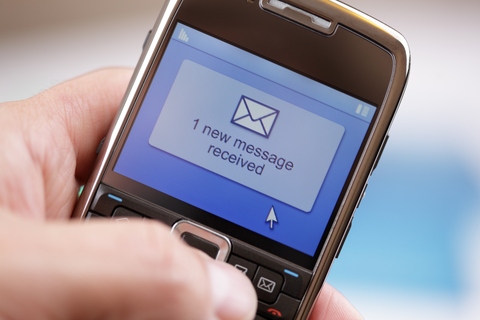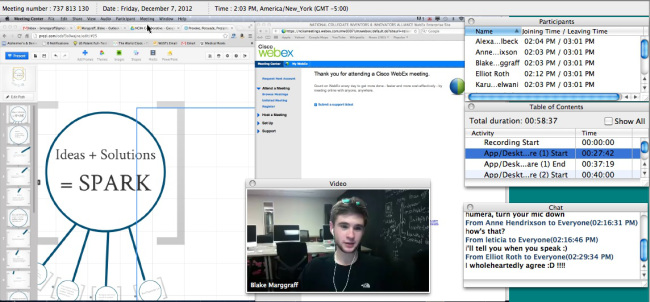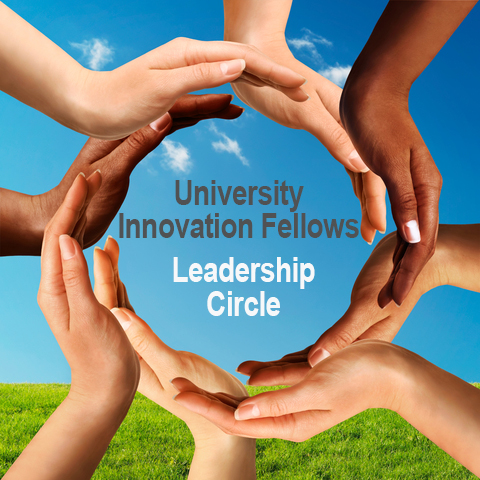Three Critical Remote Leadership Skills I Learned as a University Innovation Fellow
Three Critical Remote Leadership Skills I Learned as a University Innovation Fellow
(Useful, since my cofounder lives 500 miles away!)
By Blake Margraff
Note: These thoughts and stories, and whatever messages or lessons they may convey, are not limited to the experiences of University Innovation Fellows (formerly Student Ambassadors Program). Perhaps one of the most significant strengths of the University Innovation Fellowship is its ability to quite accurately simulate student entrepreneurship; the two are not mutually exclusive!
Part I: Accessibility keeps a team transparent and energized (as long as you have well-established limits!)
 During my trip to the Stanford d.school following the University Innovation Fellow training, I remember Elliot Roth (read his articles!) turning to me and excitedly saying, “I love it when my team sends me emails.” This simple statement is more profound than it might seem at first. Elliot, a strong leader and budding entrepreneur, inadvertently hit upon one of the most important pillars of remote leadership: keep yourself accessible! By receiving and (if necessary) acting upon the emails we receive, leading a team suddenly becomes quite rewarding, even invigorating, and the benefit is mirrored right back onto the team itself.
During my trip to the Stanford d.school following the University Innovation Fellow training, I remember Elliot Roth (read his articles!) turning to me and excitedly saying, “I love it when my team sends me emails.” This simple statement is more profound than it might seem at first. Elliot, a strong leader and budding entrepreneur, inadvertently hit upon one of the most important pillars of remote leadership: keep yourself accessible! By receiving and (if necessary) acting upon the emails we receive, leading a team suddenly becomes quite rewarding, even invigorating, and the benefit is mirrored right back onto the team itself.
However, as with most habits, accessibility in moderation is the best bet. If you’re getting calls and “urgent” emails in the wee hours of the morning on a daily basis, the simple solution is to establish working hours. Mine are from 7:30am to 11:00pm in whatever time zone I’m currently living. I can hear it now: “Blake, you crazy fool, I’ll never receive that many emails! And certainly not at those hours!” My only advice–wait and watch. As you pursue more exciting and intense projects and even companies, you’ll need to balance new parameters within your life. On that note, a few tips!
Three tips to make it happen:
1. Understand your smartphone’s “notifications” settings. Many a missed Skype call can be chalked up to the wrong alert preference. Other side of the coin, turn off your damn social alerts, especially Facebook and Snapchat; they’re timesucks (on which I’ll write another article).
2. Create an Office Hours chart for you and your team, in which everyone can simply list his or her free hours every week. It’s a pretty great feeling to be able to call up a cofounder in another state knowing that he’s probably free to chat!
3. Share your calendar with free/busy visibility (here’s how), and turn your phone on (and off) when you’ve said you will!
Part II: Timeliness becomes vital, tardiness becomes inexcusable
 When you’re the only person within hundreds of miles working on (or even leading) a project, an uncanny sensation of surrealism can sometimes sneak up on you. This, at least, has been my experience, particularly during my first startup. One cofounder was in California, another in Illinois, and there I was, out on the east side of Missouri all by my lonesome! I learned very quickly that the only way to keep the team together was through frequent communication. Perhaps surprisingly, setting up calls and shooting emails back and forth wasn’t too tricky. One of the most difficult part each week’s call, aside from agreeing upon strong, SMART goals, was getting everybody on the call and underway each time, on time.
When you’re the only person within hundreds of miles working on (or even leading) a project, an uncanny sensation of surrealism can sometimes sneak up on you. This, at least, has been my experience, particularly during my first startup. One cofounder was in California, another in Illinois, and there I was, out on the east side of Missouri all by my lonesome! I learned very quickly that the only way to keep the team together was through frequent communication. Perhaps surprisingly, setting up calls and shooting emails back and forth wasn’t too tricky. One of the most difficult part each week’s call, aside from agreeing upon strong, SMART goals, was getting everybody on the call and underway each time, on time.
As soon as I noticed what was happening, I did something that I firmly believe everyone leading a team call or videochat should do: start the call with a quick, 30-second update from everyone on the call. People enjoy talking about their own work, and the shame of missing your update is quite a motivator. I also started to insert calendar invites in any email related to scheduling, and soon, the whole team caught on and communicated much more effectively.
Three tips to make it happen:
1. Use your technology. Set reminders, become familiar with the calendar applications on your phone and computer. I have a default reminder set for 15 minutes prior to every event that’s helped me not miss many a business call.
2. Insert a calendar invite directly into any schedule-related email! This helps avoid the “I didn’t know we had a call!” excuse, and automatically corrects for time-zone confusion.
3. Start with a 30-second update from everyone on the team. Everyone likes to share personal progress, and nobody wants to the “the one who missed out.”
Part III: Message-crafting is an art worth mastering, and is most powerful when combined with careful listening
 The story for this section is short and to-the-point. Back during my second Prezi presentation to the other University Innovation Fellow candidates and NCIIA leadership (a.k.a. Humera), I knew from the beginning that my Prezi was not the fanciest, most beautiful thing I’d ever created. With that in mind, I spent the half hour leading up to the call crafting my message instead of simply focusing on adding bells and whistles to a rather skeletal visual presentation. By picking the right words (“and,” “also,” “we,” “ours,” instead of “but,” “however,” “they,” “theirs”), and deciding what exactly you want to convey, even a quick 2-4 minute presentation can become punctuated with positive phrases, enjoyable articulation, and emotionally evocative messages.
The story for this section is short and to-the-point. Back during my second Prezi presentation to the other University Innovation Fellow candidates and NCIIA leadership (a.k.a. Humera), I knew from the beginning that my Prezi was not the fanciest, most beautiful thing I’d ever created. With that in mind, I spent the half hour leading up to the call crafting my message instead of simply focusing on adding bells and whistles to a rather skeletal visual presentation. By picking the right words (“and,” “also,” “we,” “ours,” instead of “but,” “however,” “they,” “theirs”), and deciding what exactly you want to convey, even a quick 2-4 minute presentation can become punctuated with positive phrases, enjoyable articulation, and emotionally evocative messages.
Three tips to make it happen:
1. Pick a [real] message! You know you’ve gone too far when you’re rambling on about your dog’s recent bout of food poisoning, but sometimes presenters get off track without seeming to realize they’ve done so. If your message is “my school needs a physical space for innovation and creativity,” jot it down on a notecard and glance at that card every half minute.
2. Know your audience. This is the most basic one in the book. If you’re talking to students, keep the discussion student-centric. Kindergarteners and PhDs, on the other hand, will require unique (and respectively different) styles of communication.
3. Spark a dialogue when possible, if you’re comfortable with that format of communication. Making one’s self the moderator of a positive, productive discussion is a very rewarding and efficient way to convey ideas.
What’s your experience as a student leader? Post your comments below…
Blake Marggraff is a University Innovation Fellow and currently a sophomore and Biochemistry major at Washington University in St. Louis, where he is enjoying a life of academics, multiple business ventures, and the occasional hiking or camping trip. Prior to attending Washington University, Blake won the top award at Intel’s International Science and Engineering Fair with a project that used pegylated tin to augment the efficacy of radiation therapy for treatment of simulated cancer cells with low to mid-energy X-ray sources. Blake’s enthusiasm for entrepreneurship began with his success in numerous public speaking competitions, and was furthered by his work as a leader of local National Youth Leadership Training courses. Looking toward the future, Blake intends to help shape the bioethics and consumer biotechnology industries, while inspiring peers to engage in entrepreneurship. Connect with him on LinkedIn.











Leave a Reply
Want to join the discussion?Feel free to contribute!